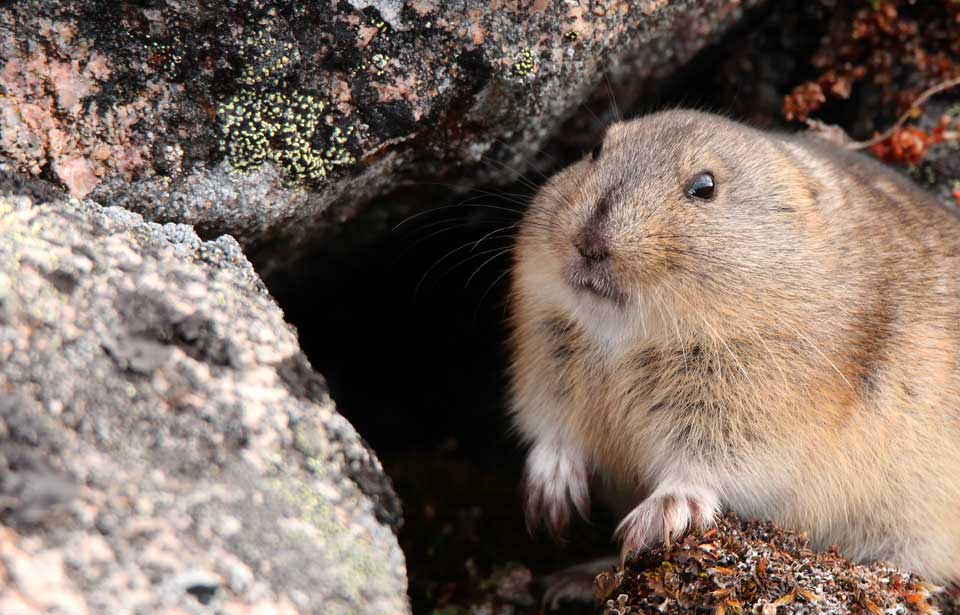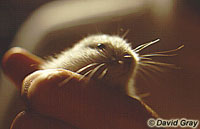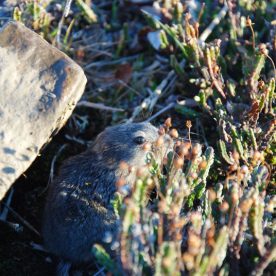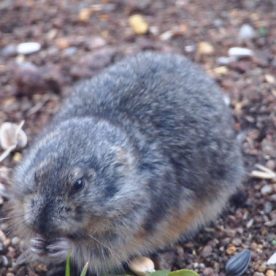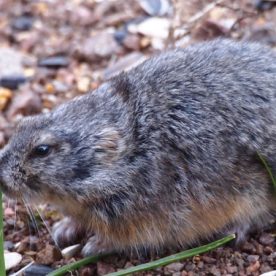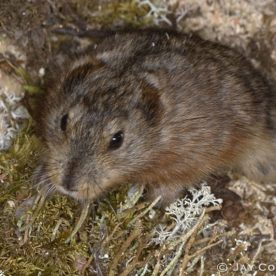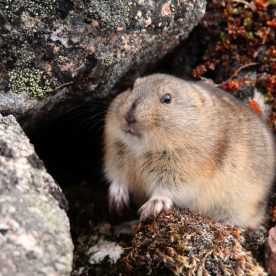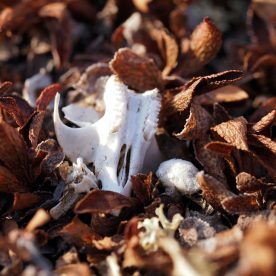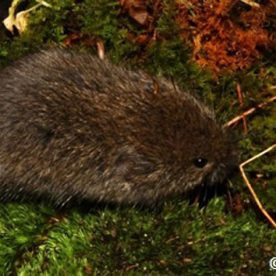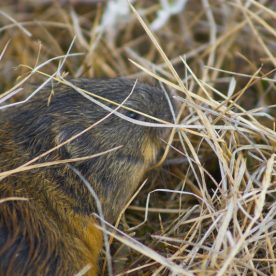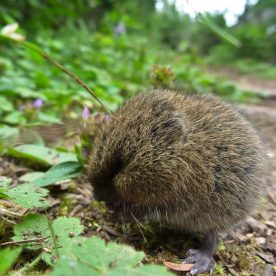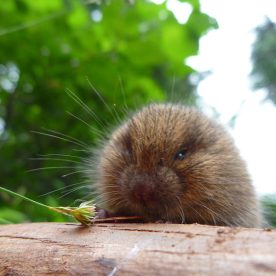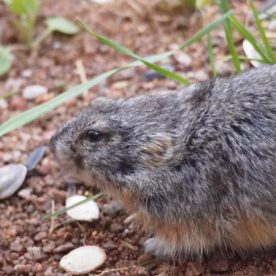Description
Lemmings are mouselike rodents that live in treeless areas of northern Canada. They have short ears, largely hidden in the fur, short legs, and short tails. Adult brown lemmings are about 150 mm in total length, including about 20 mm of tail. Their body weight varies from about 55 g in some years to about 115 g in others. Their fur is a full brown and grey summer and winter. Collared lemmings are the same overall size as brown lemmings but with a shorter tail (about 15 mm). Their colour changes with the seasons (hence their other common name, “varying lemming”). In summer, a collared lemming has a black nose, grey cheeks, tawny ear spots, a chestnut collar, and a more or less prominent black dorsal stripe. With the autumn moult, however, the summer coat is replaced by a solid white winter one and the front feet develop two greatly enlarged claws, presumably to help dig through the hard-packed tundra snow.
Unique characteristics
Lemming populations have long been known to fluctuate drastically. Peak numbers tend to recur about every four years. Furthermore, numbers are high over a huge area: for example, 1960 was a “lemming year” for almost all of the Canadian Arctic. All sorts of reasons for the cycles have been suggested, from changes in the number of sunspots to snow conditions. Weather is a likely, but still unproven, trigger. Winter creates problems for lemmings, the amount and timing and distribution of snow mitigate those problems, and peak numbers occur only following winter breeding. Unfortunately, no one has yet studied the role of snow cover in sufficient detail to prove that it causes the cycle. We do know that on Devon Island in Nunavut, collared lemmings bred during winter 1972–73, when the temperature under the snow fell below -20°C, and their population peaked the following spring.
A remarkable feature of the lemming cycle is the extreme scarcity of individuals at the “low point” of the cycle. Although several species of small rodents that live in temperate climates also reach peaks of abundance about every four years and some of them reach much higher densities at the peak than lemmings do, none can equal the extreme scarcity of lemmings at the low point. Such extreme scarcity raises the possibility of extinction. But passing through a population “bottleneck” probably strongly favours the individuals best adapted to survival in harsh arctic conditions. The cycle of every four years or so may be a device to keep selection abreast of the changes continually going on in the Arctic.
An early theory was that regular cycles of scarcity and abundance resulted from the interaction between a predator and its prey. When the prey became numerous, the predators brought down their numbers, which then resulted in death by starvation for the predator. However, the shoe now seems to be on the other foot. We know that nesting success of Snowy Owls and survival of arctic fox pups are both related to lemming abundance. Both owls and foxes produce very few, if any, surviving young except in “lemming years.” The generation of foxes born in a “lemming year” sustains the fox population, even though its numbers gradually decline, until the next lemming peak.
Another theory was the obvious one of epidemic disease periodically sweeping through the lemming population. The larger the population and the more contact between individuals in overcrowded conditions, the easier the spread of an infection. Unfortunately, no one has found a disease that is rampant in all declining lemming populations. During some declines disease is virtually absent.
Another obvious candidate is the interaction between lemmings and their food supply. As lemming numbers increase so does damage to the vegetation. Ultimately, the food supply is no longer able to sustain the population. Following a die-off of lemmings, the vegetation is able to recover, which sets the stage for a new cycle. The quantity and quality of available food are known to vary with the stage of the lemming cycle, but proof of cause and effect is still lacking.
In recent years, researchers have focused on changes in the animals themselves. The first measurable evidence came from noting changes in average weights of individuals in different phases of the cycle. In a number of species of small mammals, the largest individuals are found in the spring of the peak year. Researchers are now looking for more subtle changes. For example, increasing density produces more social interaction between individuals, which induces stress, which results in altered hormone levels, which may interfere with reproduction or alter behaviour. Stress itself may lead to increased mortality. Lemmings tend to be aggressive toward one another. If the behavioural alteration were in the direction of an increase in aggression, fewer lemmings would be born and more would be killed by their own kind.
In Scandinavia, lemmings become restless when their populations are high. In the mountainous terrain of Norway, for example, when lemmings begin to move they tend to go downhill and get funneled into valleys. The result is that large numbers eventually reach the sea or a large lake. They may proceed onto sea or lake ice or jump into the water, which has given rise to the popular conception that they are committing mass suicide to relieve a problem of overpopulation. There is, however, no authentic account from the North American Arctic to back up such a belief. Most of our Canadian lemmings live on rather flat terrain and too far from the ocean to make such migrations possible. The Inuit have no legends about migrating lemmings and it is difficult to believe that they would have overlooked such an event, especially if it occurred repeatedly.
It is certainly true that in the spring of a high population year individual lemmings will often be seen on lake and sea ice, but they do not move in an orientated manner, all going north or all going south like migrating birds, and large groups are never seen. Once on the ice, individuals run rapidly and tend to move in straight lines. Lemmings have been seen on sea ice as far as 55 km from the nearest land. We do not understand why lemmings would move onto sea and lake ice in the spring of peak years, but spring is a time of social upheaval caused by the environmental changes associated with snow melt, and the physiological changes associated with onset of the breeding season.
Habitat and Habits
The smallest of the mammals of the High Arctic, lemmings are key species in arctic ecosystems. For unknown reasons, lemming populations fluctuate drastically, peaking about every four years and then crashing almost to extinction. Because the small bodies of lemmings are important food for ermines, arctic foxes, Snowy Owls, Gyrfalcons, and jaegers, this mysterious cycle controls the rhythm of animal life on the tundra.
Most of the range occupied by lemmings is underlain by permafrost, or soil that is always frozen, often within a few centimetres of the surface. This means that the lemmings are unable to dig deep burrows for shelter even in summer. Where the soil contains much water, however, seasonal freezing and thawing creates ridges and depressions that lemmings use for burrows and as travel routes, respectively. Brown and collared lemmings in the same general area tend to choose different habitats in summer. Collared lemmings use higher and drier sites, and brown lemmings the lower and wetter ones. This segregation coincides with the distributions of preferred forage; for example, depending on what is available, collared lemmings might seek out willows and cranberries, and brown lemmings prefer sedges, arctic cotton, and certain mosses. In winter, the habitat segregation tends to break down as collared lemmings move to lower ground where the snow is deeper and provides more shelter.
The long arctic winter is a critical time for lemmings because, unlike many species of temperate rodents, they do not hibernate. It is amazing that these small, warm-blooded animals remain active throughout the arctic winter without freezing to death. Their short appendages (ears, legs, tails) are an adaptation to reduce heat loss, and their winter fur is thicker than that of summer. As winter approaches, lemmings make large, globular nests of finely shredded grasses and sedges on the surface of the ground, which provide additional insulation when they are not out hunting for food. Snow provides critical insulation. Lemmings forage in the space that forms between soil and snow, known as subnivean space, almost never appearing on the surface. In the High Arctic, temperatures at the soil-snow interface are not exactly warm (-25°C), but they are better than those above the snow, and the difference is a key to lemming survival.
Range
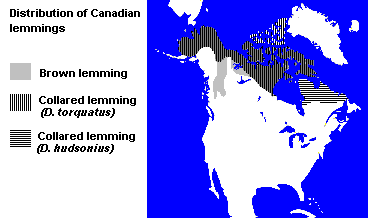 There are three lemming species in the Canadian Arctic. Two species occur on the mainland tundra west of Hudson Bay and in the southern part of the arctic archipelago: the brown lemming Lemmus sibiricus, whose range extends southwards in mountainous areas (see map), and the collared (or varying) lemming Dicrostonyx torquatus, which has colonized the Queen Elizabeth Islands right to the northern tip of Ellesmere Island. The collared (or varying) lemmings that inhabit the Ungava Peninsula are usually considered to be a separate species Dicrostonyx hudsonius.
There are three lemming species in the Canadian Arctic. Two species occur on the mainland tundra west of Hudson Bay and in the southern part of the arctic archipelago: the brown lemming Lemmus sibiricus, whose range extends southwards in mountainous areas (see map), and the collared (or varying) lemming Dicrostonyx torquatus, which has colonized the Queen Elizabeth Islands right to the northern tip of Ellesmere Island. The collared (or varying) lemmings that inhabit the Ungava Peninsula are usually considered to be a separate species Dicrostonyx hudsonius.
Similar lemming species are found in other circumpolar countries, such as Norway, Greenland, and Russia. In taxonomy, or the science of classifying organisms, brown and varying lemmings are classified as microtines, along with the muskrats, bog lemmings, and voles of southern Canada.
Breeding
Lemmings of both sexes are able to reproduce within weeks of their birth. The proportion that reproduces in the summer of their birth varies widely from year to year, and seems to be related to population density. After a year, a female is capable of producing three litters of young even in the short arctic summer, but most fail to do so. The length of the summer breeding season is related to population density. When numbers are low, breeding continues into September; when numbers are high, breeding may end in July.
Lemmings sometimes breed in the winter, but there is always a pause in spring and fall separating summer and winter breeding. How such a small mammal, already under a severe thermal stress, can muster enough energy to breed in an arctic winter, and what factors determine when winter breeding will occur, are still mysteries.
Conservation
Although lemmings have lived for up to three years in captivity, probably no lemming survives more than one winter in the wild. Wild predators likely kill most of them (except perhaps during major die-offs, when other factors, such as starvation, may come into play). In the snow-free season, arctic foxes, ermines, Snowy Owls, jaegers, and Gyrfalcons all take their toll. Wolves may take the occasional individual, and even caribou and fish have been known to prey on lemmings. Although life is more secure under the winter snow, several investigators who were on the tundra when the snow was melting have discovered remains of lemming nests that showed signs of ermine predation. The ermine is completely at home under the snow. Researchers who spent four winters in the early 1970s on Devon Island, in today’s territory of Nunavut, found that between 5 and 16 percent of lemming nests had been attacked by ermines. Even higher rates of predation by ermines have been recorded on Banks Island in the Northwest Territories and in Alaska. Snowy Owls, the only raptors, or birds of prey, present in winter, are poorly equipped for digging through snow, so an owl could only strike a lemming on the snow surface. The small arctic fox can dig through the wind-packed tundra snow, but the energy cost is high for such a small meal.
In general, lemmings are not threatened by human activity except locally around villages, mines, oil wells, and other industrial sites. Adverse weather conditions probably kill a fair number. In fall, early onset of low temperatures in the absence of snow is potentially lethal. And in spring, during snow melt, when the insulating quality of snow declines, lemmings can find themselves at the mercy of the elements if the weather turns nasty. Winter nests may be full of water, and summer burrows plugged with ice due to refreezing of the melting snow. Although lemmings are known to suffer from a number of infectious diseases and to harbour a variety of parasites, relatively few lemmings die of diseases or parasites.
Inuit do not eat lemmings, nor do they make any use of their small skins. However, those Inuit who support themselves in whole or in part by trapping benefit indirectly from the “run” of arctic foxes that follows each lemming peak.
One of the Inuit names for the collared lemming is kilangmiutak, which means “one-who-comes-from-the-sky.” The legend of lemmings falling from the sky is common to Inuit all across the North American Arctic and Scandinavia. It probably arose because of the sudden appearance of lemmings when the snow melts following a winter of intensive reproduction. Lemmings, particularly the collared lemming with its presumed origin from the sky, were sometimes used by shamans as a source of supernatural powers.
Lemmings are a vital part of the rather simple web of life on the tundra, and they help to teach us how intricate even that simple ecosystem is. Their burrowing changes the arctic soil. Their feeding habits influence the composition of the plant community on the tundra. And trappers appreciate them for another reason. Because arctic fox numbers rise and fall according to the abundance of lemmings, the income of people who depend on fox trapping for a livelihood is linked to lemmings. The influence of lemmings extends far beyond the Arctic. A lemming population decline may produce a surplus of Snowy Owls that will, for a time, flood into southern Canada to the delight of bird watchers. Meanwhile, the tundra ecosystem is gathering its resources in preparation for the outburst of energy that will come with the next lemming year.
Resources
Online Resources
Centre for Northern Studies, Lemmings
Arctic Lemmings: keystone species in a changing environment
Print resources
Banfield, A.W.F. 1974. The mammals of Canada. University of Toronto Press, Toronto.
Elton, C. 1942. Voles, mice and lemmings. Oxford, London.
Freuchen, P., and F. Solomonsen. 1958. The arctic year. Putnam’s, New York.
Macdonald, D. W. 1984. The encyclopedia of mammals. Facts on File Inc. New York.
Marsden, W. 1964. The lemming year. Chatto and Windus, London.
© Her Majesty the Queen in Right of Canada, represented by the Minister of the Environment, 1994. All rights reserved.
Catalogue number CW69-4/31-1994E
ISBN 0-662-21440-4
Text: W.A. Fuller
Photos: David Gray and S.D. MacDonald



